Ethics and Corporate Social Responsibility
VerifiedAdded on 2023/04/20
|14
|2416
|286
AI Summary
This report provides an overview of the management related aspects of Coca Cola in regard to its failure in maintaining ethical behavior. It focuses on the Plachimada Coca-Cola struggle that led to the closure of the firm.
Contribute Materials
Your contribution can guide someone’s learning journey. Share your
documents today.
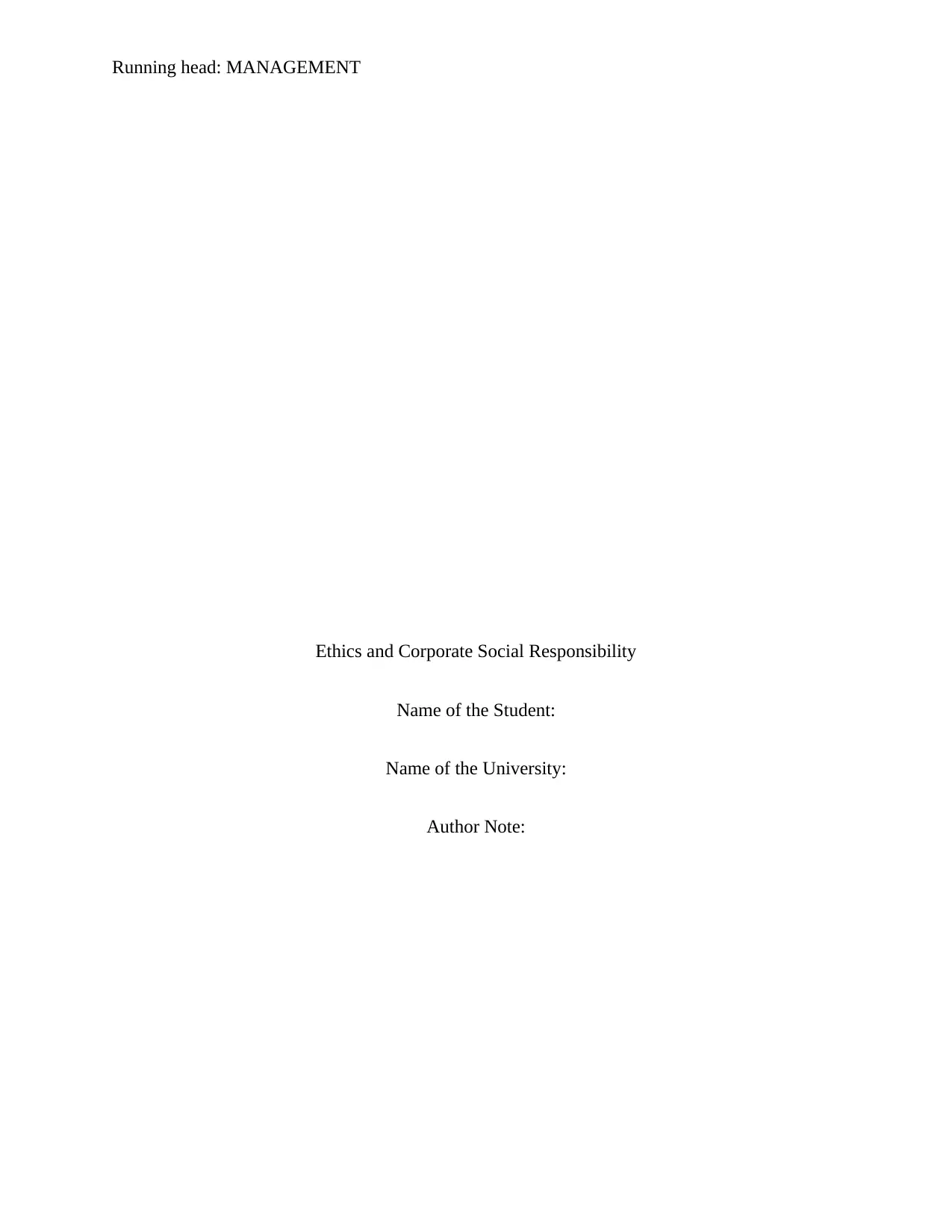
Running head: MANAGEMENT
Ethics and Corporate Social Responsibility
Name of the Student:
Name of the University:
Author Note:
Ethics and Corporate Social Responsibility
Name of the Student:
Name of the University:
Author Note:
Secure Best Marks with AI Grader
Need help grading? Try our AI Grader for instant feedback on your assignments.
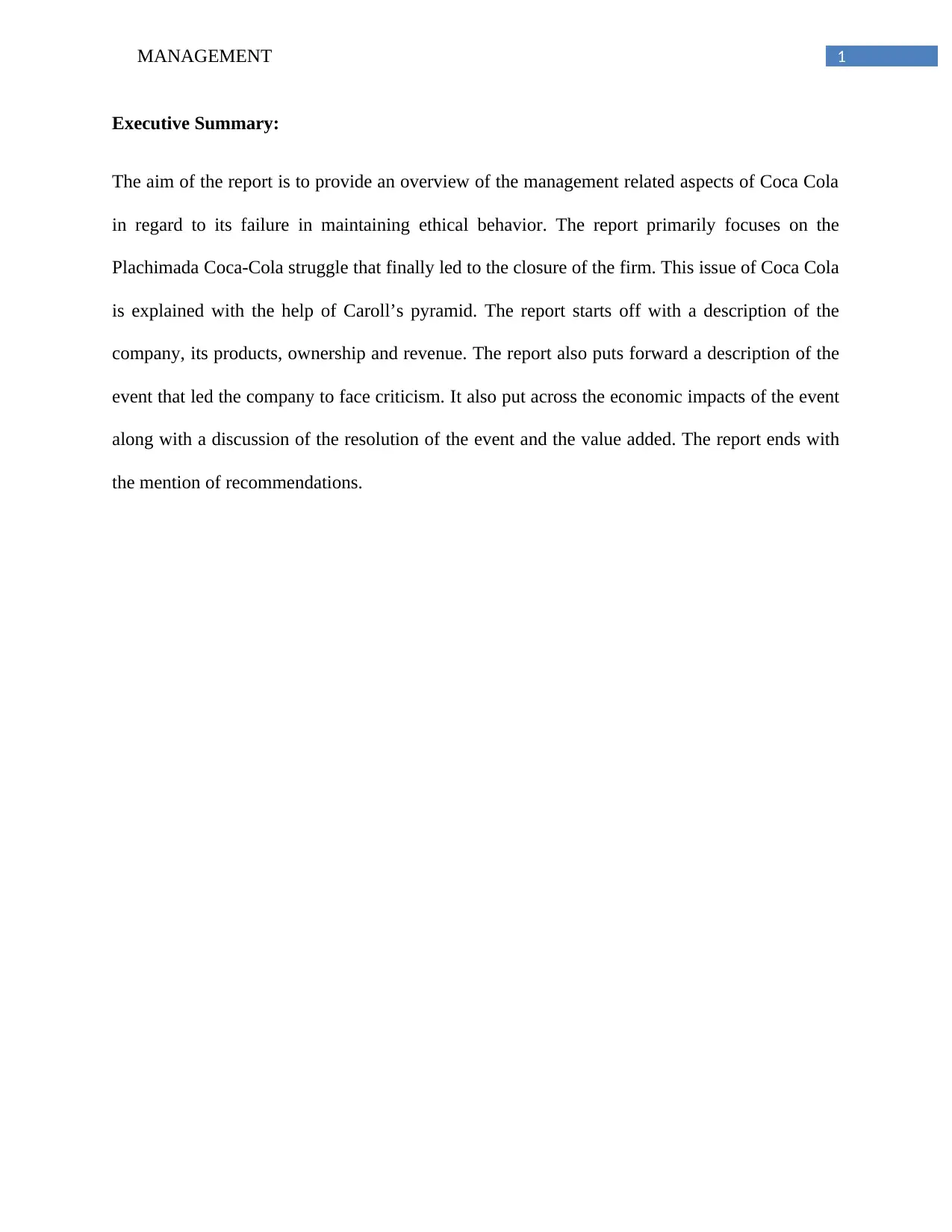
1MANAGEMENT
Executive Summary:
The aim of the report is to provide an overview of the management related aspects of Coca Cola
in regard to its failure in maintaining ethical behavior. The report primarily focuses on the
Plachimada Coca-Cola struggle that finally led to the closure of the firm. This issue of Coca Cola
is explained with the help of Caroll’s pyramid. The report starts off with a description of the
company, its products, ownership and revenue. The report also puts forward a description of the
event that led the company to face criticism. It also put across the economic impacts of the event
along with a discussion of the resolution of the event and the value added. The report ends with
the mention of recommendations.
Executive Summary:
The aim of the report is to provide an overview of the management related aspects of Coca Cola
in regard to its failure in maintaining ethical behavior. The report primarily focuses on the
Plachimada Coca-Cola struggle that finally led to the closure of the firm. This issue of Coca Cola
is explained with the help of Caroll’s pyramid. The report starts off with a description of the
company, its products, ownership and revenue. The report also puts forward a description of the
event that led the company to face criticism. It also put across the economic impacts of the event
along with a discussion of the resolution of the event and the value added. The report ends with
the mention of recommendations.
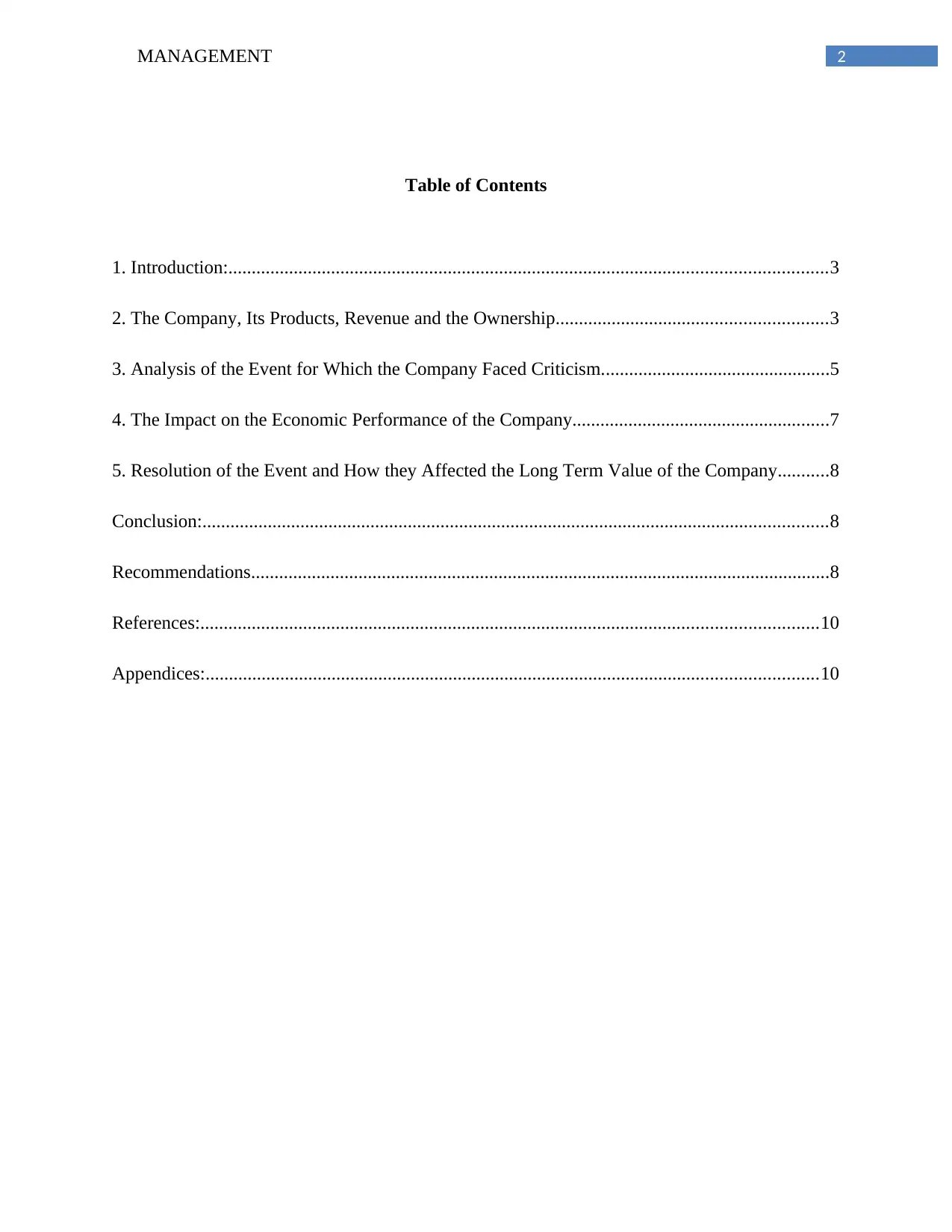
2MANAGEMENT
Table of Contents
1. Introduction:................................................................................................................................3
2. The Company, Its Products, Revenue and the Ownership..........................................................3
3. Analysis of the Event for Which the Company Faced Criticism.................................................5
4. The Impact on the Economic Performance of the Company.......................................................7
5. Resolution of the Event and How they Affected the Long Term Value of the Company...........8
Conclusion:......................................................................................................................................8
Recommendations............................................................................................................................8
References:....................................................................................................................................10
Appendices:...................................................................................................................................10
Table of Contents
1. Introduction:................................................................................................................................3
2. The Company, Its Products, Revenue and the Ownership..........................................................3
3. Analysis of the Event for Which the Company Faced Criticism.................................................5
4. The Impact on the Economic Performance of the Company.......................................................7
5. Resolution of the Event and How they Affected the Long Term Value of the Company...........8
Conclusion:......................................................................................................................................8
Recommendations............................................................................................................................8
References:....................................................................................................................................10
Appendices:...................................................................................................................................10
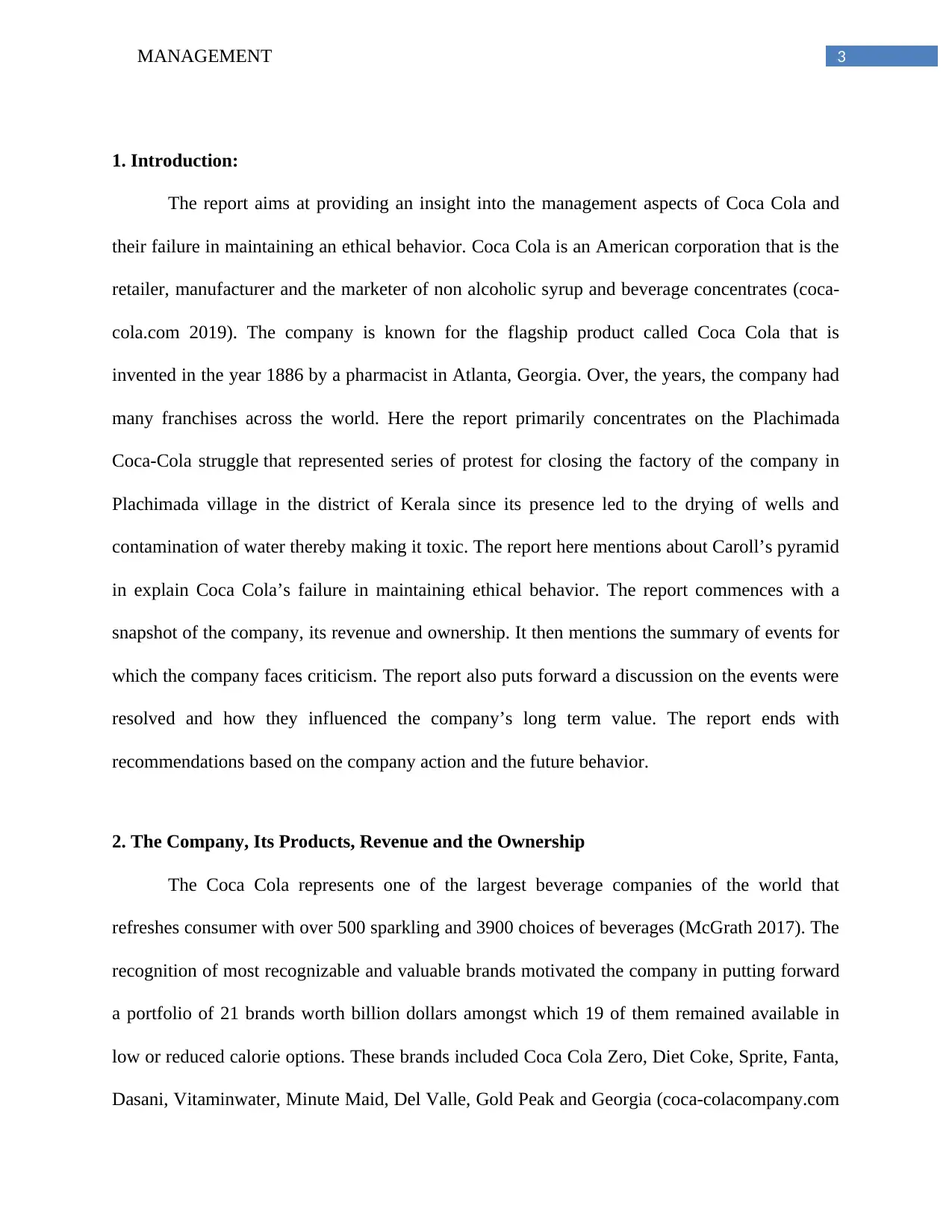
3MANAGEMENT
1. Introduction:
The report aims at providing an insight into the management aspects of Coca Cola and
their failure in maintaining an ethical behavior. Coca Cola is an American corporation that is the
retailer, manufacturer and the marketer of non alcoholic syrup and beverage concentrates (coca-
cola.com 2019). The company is known for the flagship product called Coca Cola that is
invented in the year 1886 by a pharmacist in Atlanta, Georgia. Over, the years, the company had
many franchises across the world. Here the report primarily concentrates on the Plachimada
Coca-Cola struggle that represented series of protest for closing the factory of the company in
Plachimada village in the district of Kerala since its presence led to the drying of wells and
contamination of water thereby making it toxic. The report here mentions about Caroll’s pyramid
in explain Coca Cola’s failure in maintaining ethical behavior. The report commences with a
snapshot of the company, its revenue and ownership. It then mentions the summary of events for
which the company faces criticism. The report also puts forward a discussion on the events were
resolved and how they influenced the company’s long term value. The report ends with
recommendations based on the company action and the future behavior.
2. The Company, Its Products, Revenue and the Ownership
The Coca Cola represents one of the largest beverage companies of the world that
refreshes consumer with over 500 sparkling and 3900 choices of beverages (McGrath 2017). The
recognition of most recognizable and valuable brands motivated the company in putting forward
a portfolio of 21 brands worth billion dollars amongst which 19 of them remained available in
low or reduced calorie options. These brands included Coca Cola Zero, Diet Coke, Sprite, Fanta,
Dasani, Vitaminwater, Minute Maid, Del Valle, Gold Peak and Georgia (coca-colacompany.com
1. Introduction:
The report aims at providing an insight into the management aspects of Coca Cola and
their failure in maintaining an ethical behavior. Coca Cola is an American corporation that is the
retailer, manufacturer and the marketer of non alcoholic syrup and beverage concentrates (coca-
cola.com 2019). The company is known for the flagship product called Coca Cola that is
invented in the year 1886 by a pharmacist in Atlanta, Georgia. Over, the years, the company had
many franchises across the world. Here the report primarily concentrates on the Plachimada
Coca-Cola struggle that represented series of protest for closing the factory of the company in
Plachimada village in the district of Kerala since its presence led to the drying of wells and
contamination of water thereby making it toxic. The report here mentions about Caroll’s pyramid
in explain Coca Cola’s failure in maintaining ethical behavior. The report commences with a
snapshot of the company, its revenue and ownership. It then mentions the summary of events for
which the company faces criticism. The report also puts forward a discussion on the events were
resolved and how they influenced the company’s long term value. The report ends with
recommendations based on the company action and the future behavior.
2. The Company, Its Products, Revenue and the Ownership
The Coca Cola represents one of the largest beverage companies of the world that
refreshes consumer with over 500 sparkling and 3900 choices of beverages (McGrath 2017). The
recognition of most recognizable and valuable brands motivated the company in putting forward
a portfolio of 21 brands worth billion dollars amongst which 19 of them remained available in
low or reduced calorie options. These brands included Coca Cola Zero, Diet Coke, Sprite, Fanta,
Dasani, Vitaminwater, Minute Maid, Del Valle, Gold Peak and Georgia (coca-colacompany.com
Secure Best Marks with AI Grader
Need help grading? Try our AI Grader for instant feedback on your assignments.
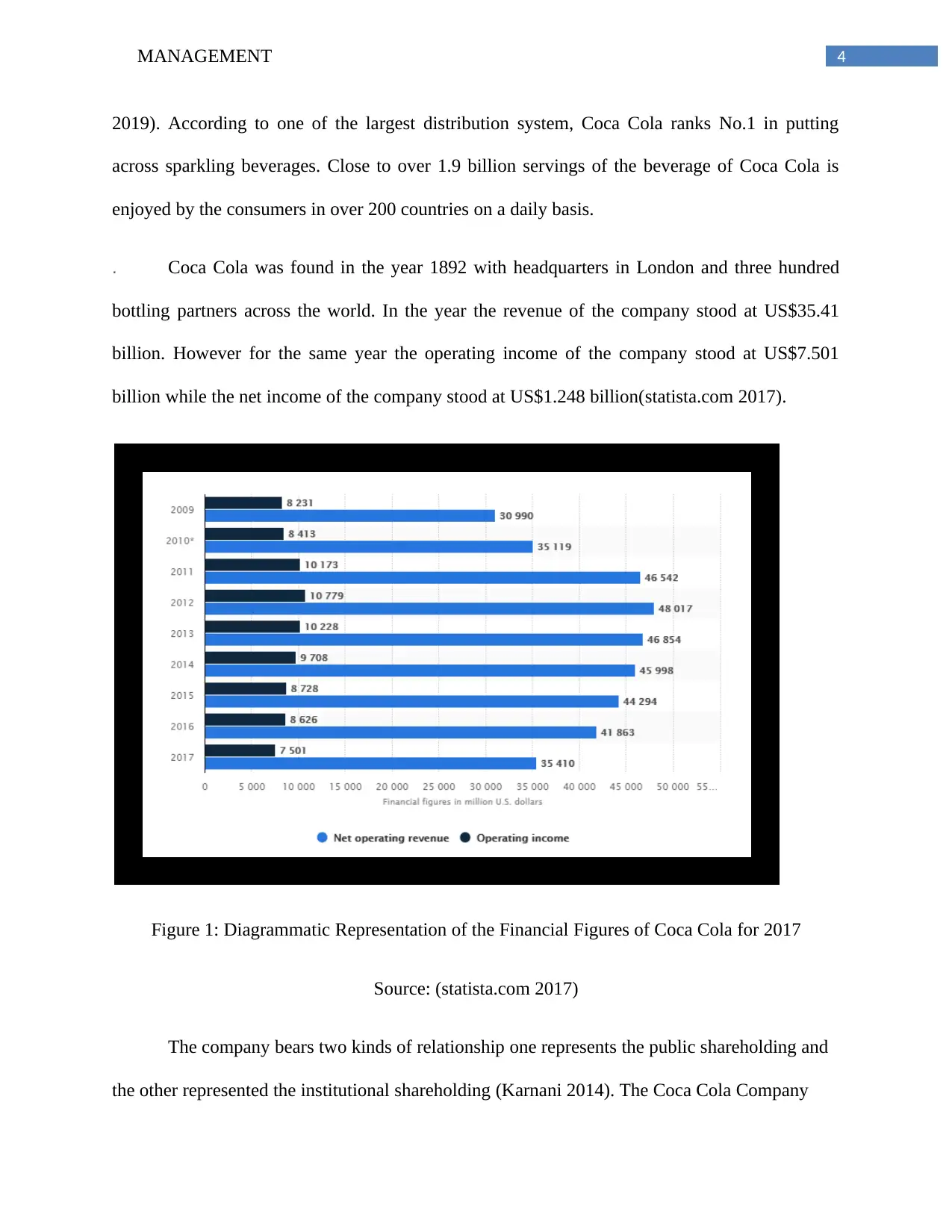
4MANAGEMENT
2019). According to one of the largest distribution system, Coca Cola ranks No.1 in putting
across sparkling beverages. Close to over 1.9 billion servings of the beverage of Coca Cola is
enjoyed by the consumers in over 200 countries on a daily basis.
. Coca Cola was found in the year 1892 with headquarters in London and three hundred
bottling partners across the world. In the year the revenue of the company stood at US$35.41
billion. However for the same year the operating income of the company stood at US$7.501
billion while the net income of the company stood at US$1.248 billion(statista.com 2017).
Figure 1: Diagrammatic Representation of the Financial Figures of Coca Cola for 2017
Source: (statista.com 2017)
The company bears two kinds of relationship one represents the public shareholding and
the other represented the institutional shareholding (Karnani 2014). The Coca Cola Company
2019). According to one of the largest distribution system, Coca Cola ranks No.1 in putting
across sparkling beverages. Close to over 1.9 billion servings of the beverage of Coca Cola is
enjoyed by the consumers in over 200 countries on a daily basis.
. Coca Cola was found in the year 1892 with headquarters in London and three hundred
bottling partners across the world. In the year the revenue of the company stood at US$35.41
billion. However for the same year the operating income of the company stood at US$7.501
billion while the net income of the company stood at US$1.248 billion(statista.com 2017).
Figure 1: Diagrammatic Representation of the Financial Figures of Coca Cola for 2017
Source: (statista.com 2017)
The company bears two kinds of relationship one represents the public shareholding and
the other represented the institutional shareholding (Karnani 2014). The Coca Cola Company

5MANAGEMENT
trades its shares as public company in New Year Stock Exchange whose shares are owned by
various investors and shareholders across the world. The shareholders owns close to 5 million
shares that represented close to 24.6 percent of the total shares of the company. As far as the
institutional share holding is concerned, the company remains owned by FEMSA, a Mexican
multinational retail and beverage company. It owns close to about 10 million shares that roughly
comprises 50 percent of the total shares of the company. Other institutions that own Coca Cola
are its entirely owned subsidiaries operating under the brand name Coca Cola. These subsidiaries
owns close to about 6 million shares thereby representing 36b percent of the total shares.
3. Analysis of the Event for Which the Company Faced Criticism.
In the year 1999, a subsidiary of the Coca Cola Company established for its license for
establishment of a factory in the Plachimada village of Kerala(Berglund and Helander 2015).
The company was however granted permission in the year 2000 for opening the factory. The
company purchased close to about 34.64 acre of land that had earlier been used for cultivating
peanuts rice and vegetables. In addition the company employed close 250 temporary laborers and
130 permanent employees. The Plachimada factory produced Limca, Fanta, Sprite, Kinley,
Thumps up, Maaza and Soda.
Within a short while, the villagers however began to take notice that the well not only ran
dry but the water available is toxic and contaminated (Mohan and Routray 2015). The waste
from factory passed off as fertilizers to the farmers. It was however confirmed through the
laboratory test that the sludge had higher percentage of lead and cadmium.
A protest movement was launched in the year 2002 by the Anti-Coca Cola Peoples
Struggle Committee after sufficient evidence that the factory was not only polluting the
trades its shares as public company in New Year Stock Exchange whose shares are owned by
various investors and shareholders across the world. The shareholders owns close to 5 million
shares that represented close to 24.6 percent of the total shares of the company. As far as the
institutional share holding is concerned, the company remains owned by FEMSA, a Mexican
multinational retail and beverage company. It owns close to about 10 million shares that roughly
comprises 50 percent of the total shares of the company. Other institutions that own Coca Cola
are its entirely owned subsidiaries operating under the brand name Coca Cola. These subsidiaries
owns close to about 6 million shares thereby representing 36b percent of the total shares.
3. Analysis of the Event for Which the Company Faced Criticism.
In the year 1999, a subsidiary of the Coca Cola Company established for its license for
establishment of a factory in the Plachimada village of Kerala(Berglund and Helander 2015).
The company was however granted permission in the year 2000 for opening the factory. The
company purchased close to about 34.64 acre of land that had earlier been used for cultivating
peanuts rice and vegetables. In addition the company employed close 250 temporary laborers and
130 permanent employees. The Plachimada factory produced Limca, Fanta, Sprite, Kinley,
Thumps up, Maaza and Soda.
Within a short while, the villagers however began to take notice that the well not only ran
dry but the water available is toxic and contaminated (Mohan and Routray 2015). The waste
from factory passed off as fertilizers to the farmers. It was however confirmed through the
laboratory test that the sludge had higher percentage of lead and cadmium.
A protest movement was launched in the year 2002 by the Anti-Coca Cola Peoples
Struggle Committee after sufficient evidence that the factory was not only polluting the

6MANAGEMENT
environment but was causing harm to the local citizens (Panicker 2013). The movement blocked
the entrance to the factory. Close to 1300 people took part in the movement that even included
women. It has also been proved through various scientific tests that the water of the well is
neither fit for human consumption, nor for the domestic use nor irrigation. The results of these
test has been supported by the primary health center of the government.
The above instance can be explained in respect of Caroll’s Pyramid of corporate social
responsibility Caroll put forward the concept of the corporate social responsibility (CSR) that
states that organizations possess four responsibilities of the business that includes, economic,
legal, ethical and discretionary(Suliman, Al-Khatib and Thomas 2016). These four components
are not mutually exclusive but complement each other. It is represented as follows:
environment but was causing harm to the local citizens (Panicker 2013). The movement blocked
the entrance to the factory. Close to 1300 people took part in the movement that even included
women. It has also been proved through various scientific tests that the water of the well is
neither fit for human consumption, nor for the domestic use nor irrigation. The results of these
test has been supported by the primary health center of the government.
The above instance can be explained in respect of Caroll’s Pyramid of corporate social
responsibility Caroll put forward the concept of the corporate social responsibility (CSR) that
states that organizations possess four responsibilities of the business that includes, economic,
legal, ethical and discretionary(Suliman, Al-Khatib and Thomas 2016). These four components
are not mutually exclusive but complement each other. It is represented as follows:
Paraphrase This Document
Need a fresh take? Get an instant paraphrase of this document with our AI Paraphraser

7MANAGEMENT
Figure 2: Diagrammatic Representation of Caroll’s Pyramid of Corporate Social
Responsibility
Source: (Nalband and Kelabi 2014)
In regard to the events of Coca in this particular case, the report considers the aspects of
ethical responsibility of the Caroll’s Pyramid. The philanthropic and ethical aspect of Carol
means good behavior is the one that is perceived the society. It also mentions that organizations
should include expectations and norms not mentioned in the law. This primarily refers to the
rights and the moral values (Visser, McIntosh and Middleton 2017). The firms also remain
obligated for acting voluntarily beyond the scopes of the business and the ethical rational acts.
This referred to also the social and philanthropic responsibility that would serve as the guideline
for business in future. In this regard it can be said that Coca Cola did not maintain the ethical
aspects while operating in Plachimada village of Kerala. It is not only disrupted the norms of the
ethical aspects but also caused immense harm to the villagers by contaminations the water with
poisonous chemicals.
4. The Impact on the Economic Performance of the Company
The Plachimada struggle of Kerala against the Coca Cola raised issues about not only the
mindless destruction of the groundwater by the multinational but also provide an exposure to the
gross inadequacies in the governance laws and the rights to the water. This led to the immediate
closure of the factory outlet. The productions halted thereby resulting in huge financial loss.
Besides, the shutdown also made people jobless. In addition to this, the Plachimada struggle
against Coca Cola also witnessed violations of the human right and resulted in the loss of the
landscape.
Figure 2: Diagrammatic Representation of Caroll’s Pyramid of Corporate Social
Responsibility
Source: (Nalband and Kelabi 2014)
In regard to the events of Coca in this particular case, the report considers the aspects of
ethical responsibility of the Caroll’s Pyramid. The philanthropic and ethical aspect of Carol
means good behavior is the one that is perceived the society. It also mentions that organizations
should include expectations and norms not mentioned in the law. This primarily refers to the
rights and the moral values (Visser, McIntosh and Middleton 2017). The firms also remain
obligated for acting voluntarily beyond the scopes of the business and the ethical rational acts.
This referred to also the social and philanthropic responsibility that would serve as the guideline
for business in future. In this regard it can be said that Coca Cola did not maintain the ethical
aspects while operating in Plachimada village of Kerala. It is not only disrupted the norms of the
ethical aspects but also caused immense harm to the villagers by contaminations the water with
poisonous chemicals.
4. The Impact on the Economic Performance of the Company
The Plachimada struggle of Kerala against the Coca Cola raised issues about not only the
mindless destruction of the groundwater by the multinational but also provide an exposure to the
gross inadequacies in the governance laws and the rights to the water. This led to the immediate
closure of the factory outlet. The productions halted thereby resulting in huge financial loss.
Besides, the shutdown also made people jobless. In addition to this, the Plachimada struggle
against Coca Cola also witnessed violations of the human right and resulted in the loss of the
landscape.
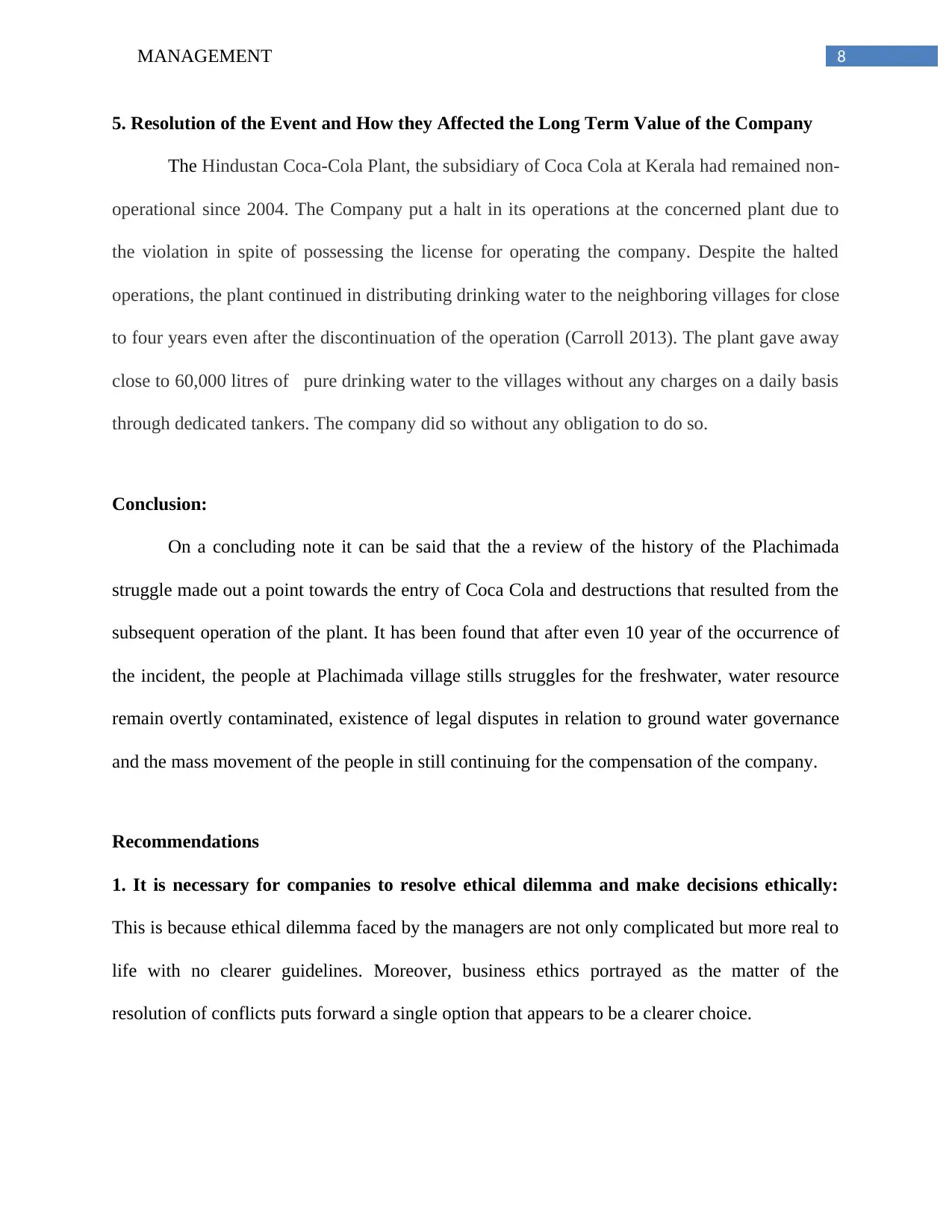
8MANAGEMENT
5. Resolution of the Event and How they Affected the Long Term Value of the Company
The Hindustan Coca-Cola Plant, the subsidiary of Coca Cola at Kerala had remained non-
operational since 2004. The Company put a halt in its operations at the concerned plant due to
the violation in spite of possessing the license for operating the company. Despite the halted
operations, the plant continued in distributing drinking water to the neighboring villages for close
to four years even after the discontinuation of the operation (Carroll 2013). The plant gave away
close to 60,000 litres of pure drinking water to the villages without any charges on a daily basis
through dedicated tankers. The company did so without any obligation to do so.
Conclusion:
On a concluding note it can be said that the a review of the history of the Plachimada
struggle made out a point towards the entry of Coca Cola and destructions that resulted from the
subsequent operation of the plant. It has been found that after even 10 year of the occurrence of
the incident, the people at Plachimada village stills struggles for the freshwater, water resource
remain overtly contaminated, existence of legal disputes in relation to ground water governance
and the mass movement of the people in still continuing for the compensation of the company.
Recommendations
1. It is necessary for companies to resolve ethical dilemma and make decisions ethically:
This is because ethical dilemma faced by the managers are not only complicated but more real to
life with no clearer guidelines. Moreover, business ethics portrayed as the matter of the
resolution of conflicts puts forward a single option that appears to be a clearer choice.
5. Resolution of the Event and How they Affected the Long Term Value of the Company
The Hindustan Coca-Cola Plant, the subsidiary of Coca Cola at Kerala had remained non-
operational since 2004. The Company put a halt in its operations at the concerned plant due to
the violation in spite of possessing the license for operating the company. Despite the halted
operations, the plant continued in distributing drinking water to the neighboring villages for close
to four years even after the discontinuation of the operation (Carroll 2013). The plant gave away
close to 60,000 litres of pure drinking water to the villages without any charges on a daily basis
through dedicated tankers. The company did so without any obligation to do so.
Conclusion:
On a concluding note it can be said that the a review of the history of the Plachimada
struggle made out a point towards the entry of Coca Cola and destructions that resulted from the
subsequent operation of the plant. It has been found that after even 10 year of the occurrence of
the incident, the people at Plachimada village stills struggles for the freshwater, water resource
remain overtly contaminated, existence of legal disputes in relation to ground water governance
and the mass movement of the people in still continuing for the compensation of the company.
Recommendations
1. It is necessary for companies to resolve ethical dilemma and make decisions ethically:
This is because ethical dilemma faced by the managers are not only complicated but more real to
life with no clearer guidelines. Moreover, business ethics portrayed as the matter of the
resolution of conflicts puts forward a single option that appears to be a clearer choice.
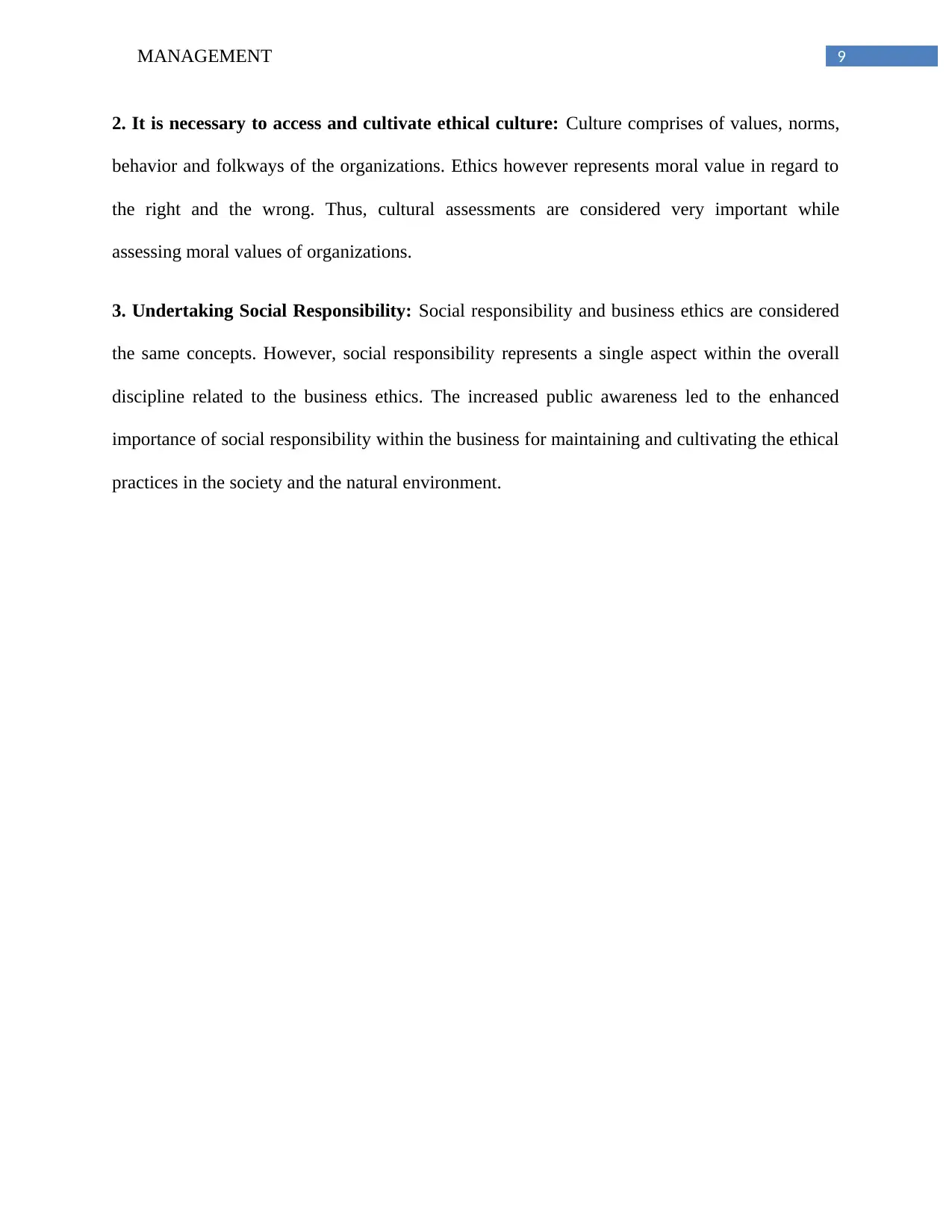
9MANAGEMENT
2. It is necessary to access and cultivate ethical culture: Culture comprises of values, norms,
behavior and folkways of the organizations. Ethics however represents moral value in regard to
the right and the wrong. Thus, cultural assessments are considered very important while
assessing moral values of organizations.
3. Undertaking Social Responsibility: Social responsibility and business ethics are considered
the same concepts. However, social responsibility represents a single aspect within the overall
discipline related to the business ethics. The increased public awareness led to the enhanced
importance of social responsibility within the business for maintaining and cultivating the ethical
practices in the society and the natural environment.
2. It is necessary to access and cultivate ethical culture: Culture comprises of values, norms,
behavior and folkways of the organizations. Ethics however represents moral value in regard to
the right and the wrong. Thus, cultural assessments are considered very important while
assessing moral values of organizations.
3. Undertaking Social Responsibility: Social responsibility and business ethics are considered
the same concepts. However, social responsibility represents a single aspect within the overall
discipline related to the business ethics. The increased public awareness led to the enhanced
importance of social responsibility within the business for maintaining and cultivating the ethical
practices in the society and the natural environment.
Secure Best Marks with AI Grader
Need help grading? Try our AI Grader for instant feedback on your assignments.
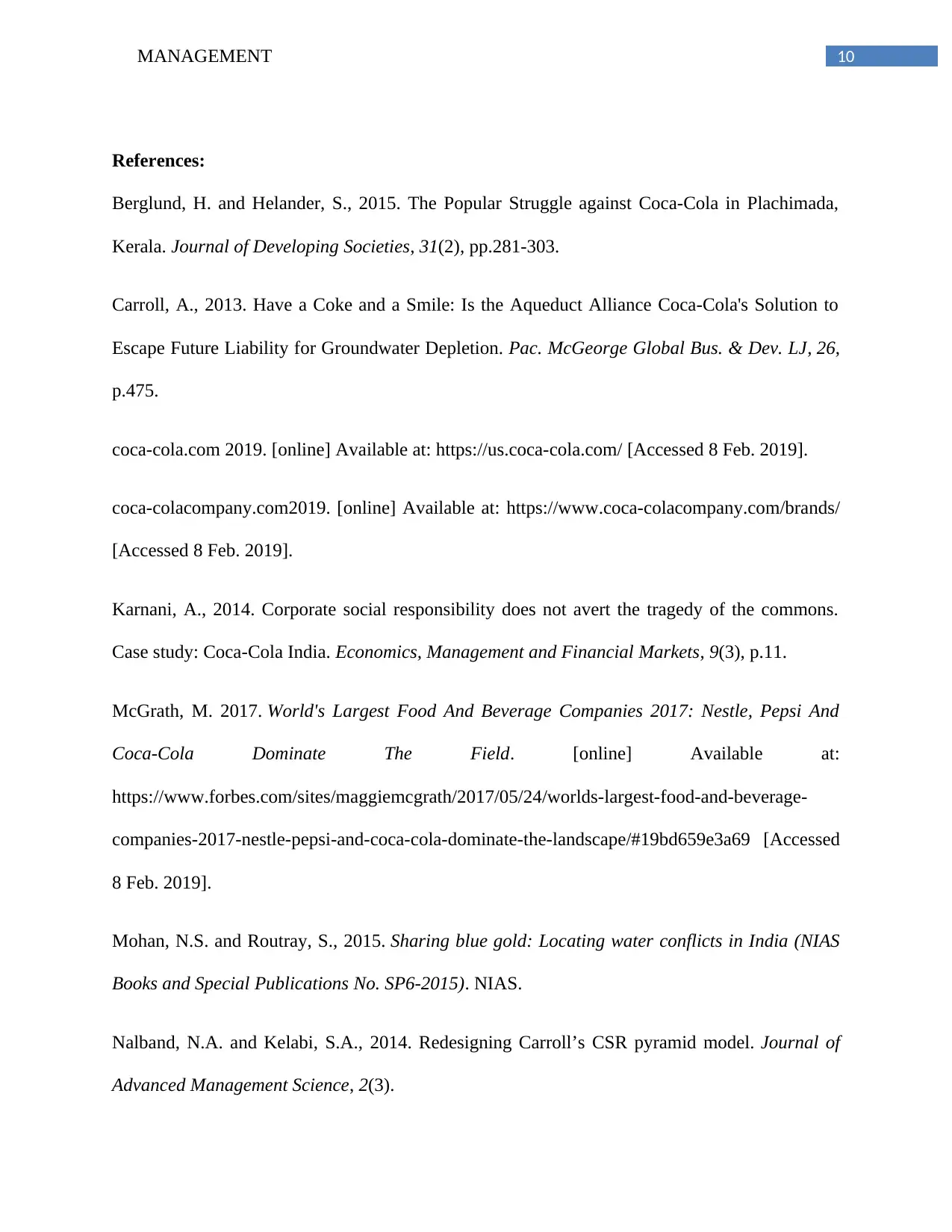
10MANAGEMENT
References:
Berglund, H. and Helander, S., 2015. The Popular Struggle against Coca-Cola in Plachimada,
Kerala. Journal of Developing Societies, 31(2), pp.281-303.
Carroll, A., 2013. Have a Coke and a Smile: Is the Aqueduct Alliance Coca-Cola's Solution to
Escape Future Liability for Groundwater Depletion. Pac. McGeorge Global Bus. & Dev. LJ, 26,
p.475.
coca-cola.com 2019. [online] Available at: https://us.coca-cola.com/ [Accessed 8 Feb. 2019].
coca-colacompany.com2019. [online] Available at: https://www.coca-colacompany.com/brands/
[Accessed 8 Feb. 2019].
Karnani, A., 2014. Corporate social responsibility does not avert the tragedy of the commons.
Case study: Coca-Cola India. Economics, Management and Financial Markets, 9(3), p.11.
McGrath, M. 2017. World's Largest Food And Beverage Companies 2017: Nestle, Pepsi And
Coca-Cola Dominate The Field. [online] Available at:
https://www.forbes.com/sites/maggiemcgrath/2017/05/24/worlds-largest-food-and-beverage-
companies-2017-nestle-pepsi-and-coca-cola-dominate-the-landscape/#19bd659e3a69 [Accessed
8 Feb. 2019].
Mohan, N.S. and Routray, S., 2015. Sharing blue gold: Locating water conflicts in India (NIAS
Books and Special Publications No. SP6-2015). NIAS.
Nalband, N.A. and Kelabi, S.A., 2014. Redesigning Carroll’s CSR pyramid model. Journal of
Advanced Management Science, 2(3).
References:
Berglund, H. and Helander, S., 2015. The Popular Struggle against Coca-Cola in Plachimada,
Kerala. Journal of Developing Societies, 31(2), pp.281-303.
Carroll, A., 2013. Have a Coke and a Smile: Is the Aqueduct Alliance Coca-Cola's Solution to
Escape Future Liability for Groundwater Depletion. Pac. McGeorge Global Bus. & Dev. LJ, 26,
p.475.
coca-cola.com 2019. [online] Available at: https://us.coca-cola.com/ [Accessed 8 Feb. 2019].
coca-colacompany.com2019. [online] Available at: https://www.coca-colacompany.com/brands/
[Accessed 8 Feb. 2019].
Karnani, A., 2014. Corporate social responsibility does not avert the tragedy of the commons.
Case study: Coca-Cola India. Economics, Management and Financial Markets, 9(3), p.11.
McGrath, M. 2017. World's Largest Food And Beverage Companies 2017: Nestle, Pepsi And
Coca-Cola Dominate The Field. [online] Available at:
https://www.forbes.com/sites/maggiemcgrath/2017/05/24/worlds-largest-food-and-beverage-
companies-2017-nestle-pepsi-and-coca-cola-dominate-the-landscape/#19bd659e3a69 [Accessed
8 Feb. 2019].
Mohan, N.S. and Routray, S., 2015. Sharing blue gold: Locating water conflicts in India (NIAS
Books and Special Publications No. SP6-2015). NIAS.
Nalband, N.A. and Kelabi, S.A., 2014. Redesigning Carroll’s CSR pyramid model. Journal of
Advanced Management Science, 2(3).
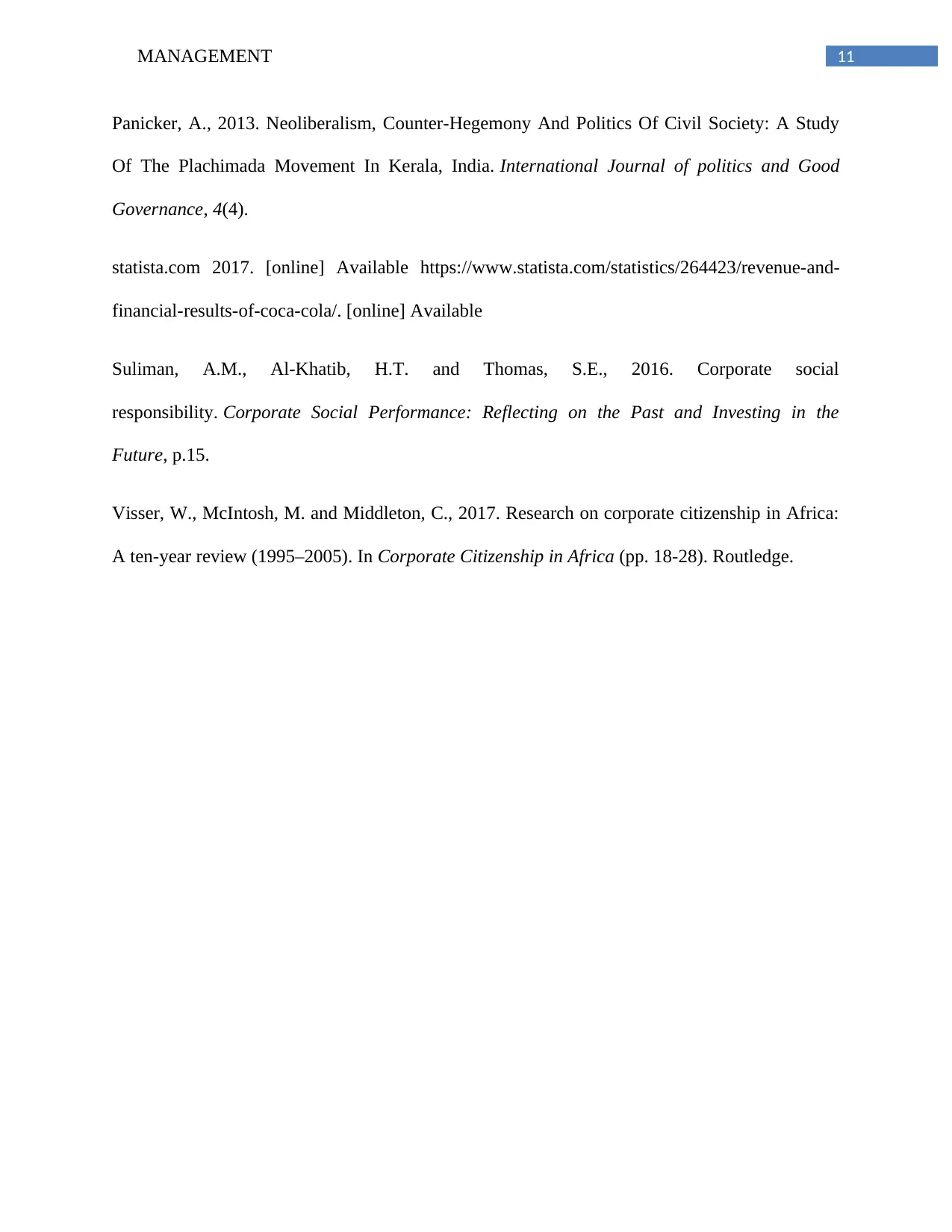
11MANAGEMENT
Panicker, A., 2013. Neoliberalism, Counter-Hegemony And Politics Of Civil Society: A Study
Of The Plachimada Movement In Kerala, India. International Journal of politics and Good
Governance, 4(4).
statista.com 2017. [online] Available https://www.statista.com/statistics/264423/revenue-and-
financial-results-of-coca-cola/. [online] Available
Suliman, A.M., Al-Khatib, H.T. and Thomas, S.E., 2016. Corporate social
responsibility. Corporate Social Performance: Reflecting on the Past and Investing in the
Future, p.15.
Visser, W., McIntosh, M. and Middleton, C., 2017. Research on corporate citizenship in Africa:
A ten-year review (1995–2005). In Corporate Citizenship in Africa (pp. 18-28). Routledge.
Panicker, A., 2013. Neoliberalism, Counter-Hegemony And Politics Of Civil Society: A Study
Of The Plachimada Movement In Kerala, India. International Journal of politics and Good
Governance, 4(4).
statista.com 2017. [online] Available https://www.statista.com/statistics/264423/revenue-and-
financial-results-of-coca-cola/. [online] Available
Suliman, A.M., Al-Khatib, H.T. and Thomas, S.E., 2016. Corporate social
responsibility. Corporate Social Performance: Reflecting on the Past and Investing in the
Future, p.15.
Visser, W., McIntosh, M. and Middleton, C., 2017. Research on corporate citizenship in Africa:
A ten-year review (1995–2005). In Corporate Citizenship in Africa (pp. 18-28). Routledge.
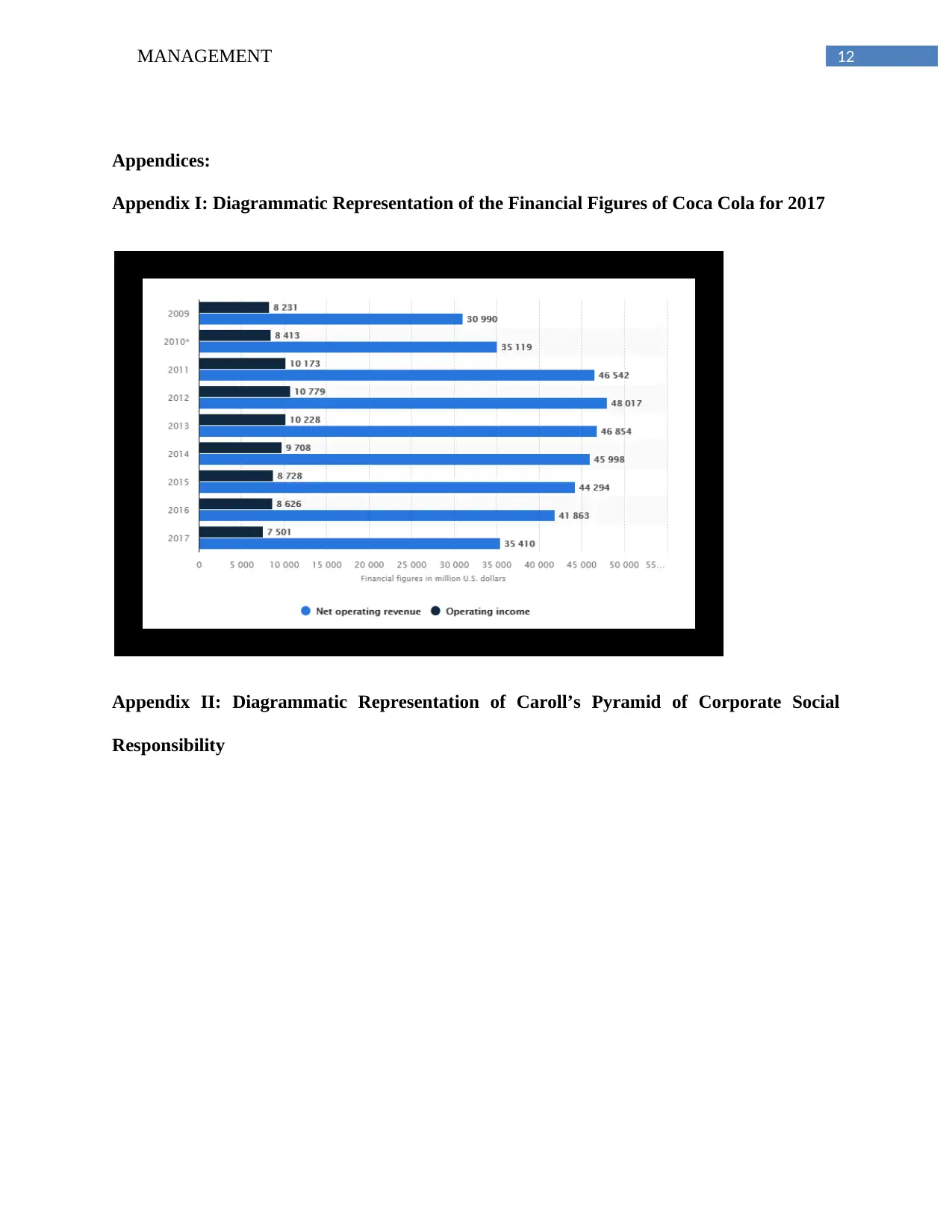
12MANAGEMENT
Appendices:
Appendix I: Diagrammatic Representation of the Financial Figures of Coca Cola for 2017
Appendix II: Diagrammatic Representation of Caroll’s Pyramid of Corporate Social
Responsibility
Appendices:
Appendix I: Diagrammatic Representation of the Financial Figures of Coca Cola for 2017
Appendix II: Diagrammatic Representation of Caroll’s Pyramid of Corporate Social
Responsibility
Paraphrase This Document
Need a fresh take? Get an instant paraphrase of this document with our AI Paraphraser
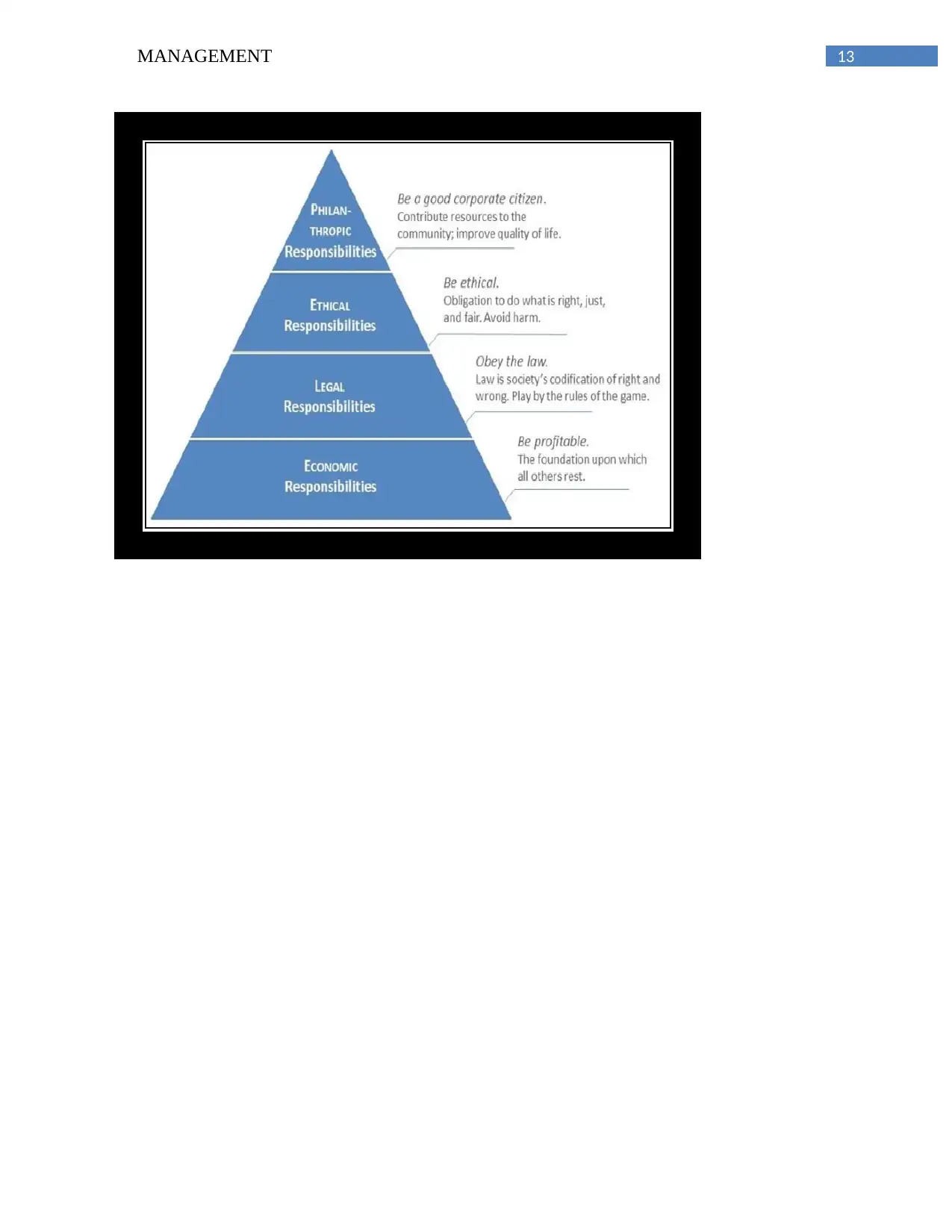
13MANAGEMENT
1 out of 14
Your All-in-One AI-Powered Toolkit for Academic Success.
+13062052269
info@desklib.com
Available 24*7 on WhatsApp / Email
![[object Object]](/_next/static/media/star-bottom.7253800d.svg)
Unlock your academic potential
© 2024 | Zucol Services PVT LTD | All rights reserved.

